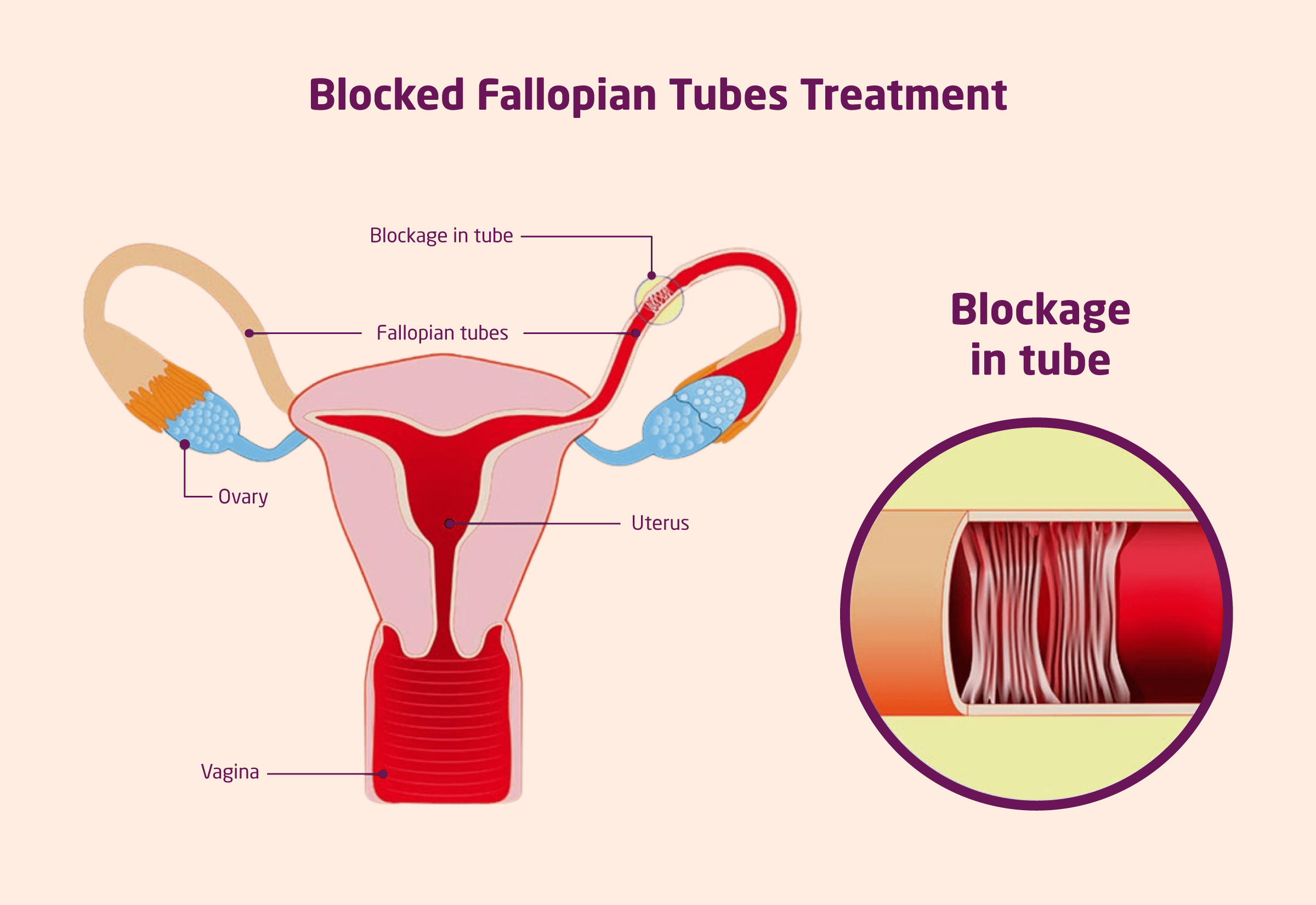Blocked Fallopian Tubes Treatment
The fallopian tubes are two tubes, one on each side of the uterus, that picks up the released egg from ovaries, allows sperm to enter in the fallopian tube, fertilization and early development of embryo occurs here. The embryo then moves towards the uterus with the help of hair-like structure in the fallopian tubes. If fertilization doesn’t occur the egg gets degenerated. When a blockage, such as scarring, an adhesion, or an infection, prevents the movement of sperm/egg/embryo in the tube, it is said to have a blocked fallopian tube, which is also referred to as tubal factor infertility. A blocked fallopian tube may affect fertility.
What are the symptoms of blocked fallopian tubes?
People who have blocked fallopian tubes rarely show any symptoms. Many people with this issue believe their fertility is normal. It’s not always the case. The first “symptom” of blocked fallopian tubes is often infertility.
Blocked fallopian tubes can occasionally cause a mild, ongoing abdominal ache on one side. This may occur in a hydrosalpinx, a form of blockage. When a blockage causes the tube to expand or grow, and fill with fluid, the condition is known as hydrosalpinx.
Blocked fallopian tubes can have a variety of causes, some of which may also have unique symptoms. For instance, painful menstruation and painful sexual activity may be brought on by endometriosis and pelvic inflammatory disease, both of these diseases may affect the tubes.
How does a blocked fallopian tube affect fertility?
One common reason for infertility is blocked fallopian tubes. In the fallopian tube, sperm and an egg come together to fertilize. And when there is a blockage in the fallopian, it prevents the sperm and egg from meeting.
You might be able to conceive with one or both partially blocked fallopian tubes. But the chance of an ectopic pregnancy rises. However, without medical help, pregnancy will not be possible if both tubes are completely blocked.
What are the causes of blocked fallopian tubes?
Pelvic inflammatory disease is the most typical cause of blocked fallopian tubes. Although not all pelvic infections are connected to STDs, but sometimes pelvic inflammatory disease is the outcome of a sexually transmitted disease. Additionally, even in the absence of PID, a history of PID or pelvic infection raises the possibility of blocked tubes.
Blockage of the fallopian tubes can also result from:
- Chlamydia and gonorrhea can result in pelvic inflammatory disease and scarring.
- Pelvic inflammatory disease can cause scarring or hydrosalpinx.
- Endometrial tissue can accumulate and block the fallopian tubes.
- Past ectopic pregnancy can scar the fallopian tubes.
- Fibroids can grow and block the fallopian tube, particularly, when they grow near the opening of fallopian tubes into the uterus
- Past abdominal surgeries, especially on the fallopian tubes themselves, can lead to pelvic adhesions that block the tubes.
How to diagnose a blocked fallopian tube?
A hysterosalpingogram(HSG) or Sonosalpingography (SSG), is a test to check for the patency of fallopian tubes.
One of the primary fertility tests that every couple having trouble getting pregnant gets is an HSG or SSG. A small tube is used to inject a dye or saline into the cervix during the test. The dye should pass through the uterus and fallopian tubes before spilling out around the ovaries and into the pelvic cavity if everything is normal. X-rays of the pelvic region are taken after the dye has been injected in HSG. Similarly, pelvic ultrasound is done to see if saline is present in the pelvic cavity. But if the dye doesn’t get past the tubes, then you may have a blocked fallopian tube.
Your doctor may use laparoscopy to perform additional testing if the tubal patency test is unable to provide a conclusive diagnosis.
How to treat blocked fallopian tubes?
Your doctor may perform laparoscopic surgery to remove any scar tissue or adhesions that are blocking your fallopian tubes and open them. However, it may not be able to treat the blockages in your fallopian tubes if there is a significant amount of scar tissue or adhesions present.
Surgery may be an option to restore tubes that have been harmed by an infection or ectopic pregnancy. Here is what you need to know about surgery for blocked tubes:
- Laparoscopic Surgery: Laparoscopic surgery may often be able to clear scar tissue or unblock blocked tubes. Unfortunately, it isn’t always effective. The possibility of success is influenced by your age, the position and severity of the blockage, as well as its underlying cause. The likelihood of becoming pregnant following surgery is good if there are only a few adhesions between the tubes and ovaries.
- In Vitro Fertilization: Women with blocked tubes had no other alternatives for getting pregnant before the introduction of in vitro fertilization (IVF), especially if repair surgery didn’t work or wasn’t an option. IVF has made it possible for such women to get pregnant as the fertilization occurs in the lab so the work of fallopian tubes are bypassed.
Takeaway
When only one fallopian tube is blocked, it may still be possible to conceive naturally or with minimal medical assistance. Surgery or IVF treatment, however, can be required when both tubes are blocked.
Following treatment for blocked fallopian tubes, pregnancy is possible. However, the type of treatment you receive and how severe the block is will affect your chances of getting pregnant. The likelihood of a successful pregnancy increases if the blockage is close to the uterus. If the blockage is at the fallopian tube’s end, close to the ovary, the success percentages are lower.

